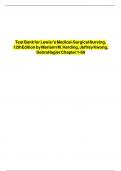Exam (elaborations)
Test bank for Lewis's Medical-Surgical Nursing: Assessment and Management of Clinical Problems 12th Edition by Marianne M. Harding, Jeffrey Kwong, Debra Hagler 9780323789615 Chapter 1-69 Complete Guide A+
Course
Medical-Surgical Nursing, 12th Edition (MEDICALSUR
Institution
Medical-Surgical Nursing, 12th Edition (MEDICALSUR
Test bank for Lewis's Medical-Surgical Nursing: Assessment and Management of Clinical Problems 12th Edition by Marianne M. Harding, Jeffrey Kwong, Debra Hagler 9780323789615 Chapter 1-69 Complete Guide A+
[Show more]
Preview 4 out of 645 pages
Uploaded on
October 15, 2024
Number of pages
645
Written in
2024/2025
Type
Exam (elaborations)
Contains
Questions & answers
Book Title: Study Guide for Lewis\'s Medical-Surgical Nursing
Author(s): Mariann M. Harding, Collin Bowman-Woodall, Collin Bowman-Woodall, RN, MS, Jeffrey Kwong, Dottie Roberts, Debra Hagler, Courtney Reinisch, Courtney Reinisch, RN, DNP, FNP-BC
Edition: 2022 ISBN: 9780323792387 Edition: Unknown
Institution
Medical-Surgical Nursing, 12th Edition (MEDICALSUR
Course
Medical-Surgical Nursing, 12th Edition (MEDICALSUR
$25.49
100% satisfaction guarantee
Immediately available after payment
Both online and in PDF
No strings attached
Test Bank for Lewis\'s Medical-Surgical Nursing,




